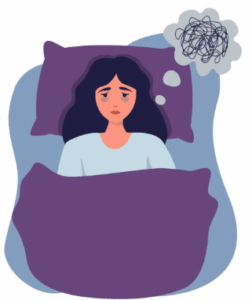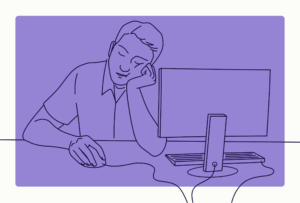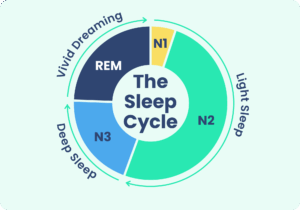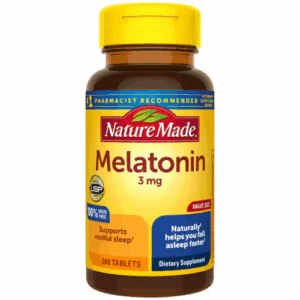Is technology helping or harming our health?
For many high school students, sleep is the sweet reward at the end of a long day. Hours spent on laptops and phones balancing homework and busy schedules all lead to a well-earned night’s rest. However, as technology becomes more prevalent in day-to-day life, its impact on health becomes increasingly significant. Many technologies like laptops and phones emit blue wavelengths of light, which impact alertness. Why is this important for sleep? Studies show that exposure to blue light can disrupt sleep quality and duration, which can lead to changes in both mental and physical health.
Blue light is a form of electromagnetic radiation, a type of energy that travels in waves or particles. This type of energy can be visualized on the electromagnetic (EM) spectrum, which shows different types of EM radiation according to their frequencies and wavelengths, such as radio waves or visible light. Blue light is located on the visible portion of the EM spectrum (380-700 nm). Each color of light has a different wavelength range (1). Blue light wavelengths are between 400nm and 500nm, and blue light’s impact on the circadian system has profound implications for sleep (2).

A diagram of the different wavelengths associated with different types of light in the visible portion of the electromagnetic spectrum.
The circadian system manages most 24-hour processes in humans, such as sleep-wake timing and hormone secretion (2). This sleep-wake cycle, also known as the circadian rhythm, lasts 24.25 hours for the average human. Those who stay up later tend to have slightly longer rhythms, and those who go to sleep earlier tend to have slightly shorter ones. (3).
Melatonin is a hormone that regulates this sleep-wake cycle. Light exposure during the day suppresses melatonin levels, while darkness at night increases them and therefore induces sleep (4). This effect correlates with the fact that throughout much of history, humans’ sleep-wake schedules were aligned with sunrise and sunset (5). Light detection by intrinsically photosensitive retinal ganglion cells (ipRGCs), located in the retina (6), influences melatonin levels (2). ipRGCs are extremely sensitive to blue wavelengths; therefore, the detection of these wavelengths greatly suppresses melatonin levels.
A study conducted by Harvard found that, in comparison to green light (495-570 nm), blue light suppressed melatonin for approximately twice as long. Additionally, a systematic review by the NIH found that blue light can decrease sleep quality and duration (7). These effects are especially impactful for students who already face the pressures of heavy academic workloads and limited work time. Research on first-year college students found that irregular sleep schedules and electronics use late at night contributed significantly to circadian delay. This misalignment of the internal sleep schedule can have long-term effects. (2). Chronic misalignment of the circadian rhythm could increase the risk of cardiovascular disease and depression.
Not all effects from blue light are negative. While it has been shown to hinder sleep, studies have found that exposure to blue light during the day can also increase attention span, mood, and overall cognitive performance (3, 7). The majority of natural blue light exposure comes from the sun, and additional exposure from devices lowers melatonin levels further. This is particularly helpful for athletes, as an increase in attention span and decrease in reaction time helps them perform better in fast-paced environments such as sports practices or games (2, 7).

This diagram shows how the brain secretes melatonin based on the amount of blue light exposure, depending on the time of day.
While blue light can keep you alert and focused during the day, it stops being beneficial at night, when the body naturally winds down. To make the most of your well-earned sleep, consider turning off devices just a little earlier each night. It might feel impossible with busy schedules, but even small steps to improve your sleep can make enough of a difference to keep you healthy and energized throughout the day.
Bibliography
- University Corporation for Atmospheric Research. (n.d.). Electromagnetic (EM) Spectrum. University Corporation for Atmospheric Research. https://scied.ucar.edu/learning-zone/earth-system/electromagnetic-spectrum#:~:text=Radio%20waves%2C%20shown%20on%20the,Radio%20Waves
- Alam, M., Abbas, K., Sharf, Y., & Khan, S. (2024). Impacts of blue light exposure from electronic devices on circadian rhythm and sleep disruption in adolescent and young adult students. Chronobiology in Medicine, 6(1), 10-14. https://doi.org/10.33069/cim.2024.0004
- Harvard Health Publishing. (n.d.). Blue light has a dark side. Harvard Health Publishing. https://www.health.harvard.edu/staying-healthy/blue-light-has-a-dark-side
- UC Davis Health. (2025, February 5). Melatonin and your sleep: Is it safe, what are the side effects and how does it work? https://health.ucdavis.edu/blog/cultivating-health/melatonin-and-your-sleep-is-it-safe-what-are-the-side-effects-and-how-does-it-work/2025/02
- Newson, R. (2025, July 11). Blue light: What it is and how it affects sleep. Sleep Foundation. https://www.sleepfoundation.org/bedroom-environment/blue-light
- Pickard, G. E., & Sollars, P. J. (2011). Intrinsically photosensitive retinal ganglion cells. Reviews of Physiology, Biochemistry and Pharmacology 162, 59-90. https://doi.org/10.1007/112_2011_4
- Silvani, M. I., Werder, R., & Perret, C. (2022). The influence of blue light on sleep, performance and wellbeing in young adults: A systematic review. Frontiers in physiology, 13, 943108. https://doi.org/10.3389/fphys.2022.943108
Images:






Comments are closed.